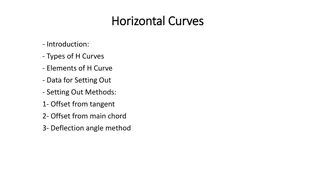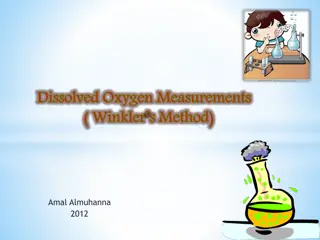Understanding Dissolved Oxygen Sag Curves in Environmental Engineering
Understanding the Dissolved Oxygen Sag Curve in streams is crucial for predicting oxygen depletion due to organic carbon input. Models like the Streeter-Phelps Model help in estimating minimum oxygen levels and distance downstream where deficits occur. This involves concepts like BOD, DO, mathematical modeling, and mass balance formulations. The critical point for minimal DO levels can be calculated to optimize environmental risk management.
Download Presentation

Please find below an Image/Link to download the presentation.
The content on the website is provided AS IS for your information and personal use only. It may not be sold, licensed, or shared on other websites without obtaining consent from the author. Download presentation by click this link. If you encounter any issues during the download, it is possible that the publisher has removed the file from their server.
E N D
Presentation Transcript
Ohio Northern University CE 3231 - Introduction to Environmental Engineering and Science Chemistry, Microbiology & Material Balance Introduction Water & Air Pollution Env Risk Management Dissolved Oxygen Sag Curve When organic carbon is placed into a stream environment, the dissolved oxygen drops following a characteristic pattern. The resulting sag curve is able to be modeled to predict the minimum oxygen concentration expected and the point along the river stretch where the deficit will occur. Readings for This Class: 5.5-5.6
Lecture 25 DO Sag Curve Streeter Phelps Model (Water Quality V)
BOD and DO Definition of BOD Calculating BODx from equation
Simple Plug Flow River Model Objective: derive a mathematical model to predict DO downstream: DO(x,t) Wastewater discharge (High BOD, Low DO) Assumptions: 1. completely and uniformly mixed in the cross flow and vertical direction 2. neglect pollutant dispersion
Formulation: Mass balance DO replenish from air A control volume in the river A A: cross section area (m2) u: flow velocity u DOin DOout x DO consumed due to oxidation
Formulation: Mass balance k L k ( ) = + k t k t k t 0 k d D e e D e d r r 0 r d
Critical Point Time/Distance @ DO=Domin Minimal occurs when dDO/dt=0 Taking the sag equation with respect to t and setting it equal to zero, then solve for t 1 k k k k = ln 1 t D r k L d r 0 c k k 0 r d d d Distance downstream where DOmin occurs = tc x u u: flow speed of the river
( )+D0e-krt kdL0 kr-kd Streeter Phelps solved for Dmax e-kdt-e-krt Dmax = 1 k k k k = ln 1 t D r k L d r Streeter Phelps solved for critical time 0 c k k 0 r d d d In-class Problem The initial BOD of a river just below a sewage outfall is 25 mg/L. The oxygen deficit just upstream from the outfall is 2 mg/L. The deoxygenation rate coefficient kd is 0.4/day, and the reacation rate coefficient kr is 0.7/day. The river is flowing at a speed of 20 miles/day. You have been asked to determine the impact of this single source on the river: a) Find the critical distance downstream at which DO is a minimum a) Find the minimum DO
1 k k k k = ln 1 t D r k L d r Solution (a) 0 c k k 0 r d d d =1.65days 1-2 0.7-0.4 0.4 25 0.7-0.4ln0.7 1 tc= 0.4 dc=tc u=1.65days 20miles/day=33miles In-class Problem The initial BOD of a river just below a sewage outfall is 25 mg/L. The oxygen deficit just upstream from the outfall is 2 mg/L. The deoxygenation rate coefficient kd is 0.4/day, and the reacation rate coefficient kr is 0.7/day. The river is flowing at a speed of 20 miles/day. You have been asked to determine the impact of this single source on the river: a) Find the critical distance downstream at which DO is a minimum a) Find the minimum DO
( )+D0e-krt kdL0 kr-kd e-kdt-e-krt Dmax = Solution (b) =7.36 0.4 25 0.7-0.4 ( )+2 e-0.7 1.65 e-0.4 1.65-e-0.7 1.65 Dmax = DOmin= DOsat-Dmax=10-7.36=2.65mg / L In-class Problem The initial BOD of a river just below a sewage outfall is 25 mg/L. The oxygen deficit just upstream from the outfall is 2 mg/L. The deoxygenation rate coefficient kd is 0.4/day, and the reacation rate coefficient kr is 0.7/day. The river is flowing at a speed of 20 miles/day. You have been asked to determine the impact of this single source on the river: a) Find the critical distance downstream at which DO is a minimum a) Find the minimum DO
( )+D0e-krt kdL0 kr-kd Streeter Phelps solved for Dmax e-kdt-e-krt Dmax = 1 k k k k = ln 1 t D r k L d r Streeter Phelps solved for critical time 0 c k k 0 r d d d What happens when there is no initial deficit? What happens where the organic loading increases? What happens if the river increases velocity?























